A Comprehensive Report on Fundamentals of Coaching Leadership
VerifiedAdded on 2023/02/01
|16
|4258
|71
Report
AI Summary
This report provides a detailed analysis of coaching as a leadership style, exploring its theoretical underpinnings, practical applications, and impact on organizational performance. The paper examines the evolution of leadership styles, highlighting the shift from command-and-control to coaching, which emphasizes employee development and empowerment. It delves into the core concepts of coaching leadership, including the leader's role in fostering employee growth, creating dynamic interactions, and promoting self-awareness. The report covers key elements of the coaching relationship, such as collaboration, commitment, and self-solving abilities. It also investigates the mechanisms of coaching, including guiding, goal-setting, and providing support. Furthermore, the report examines coaching interventions, philosophies, and their role in enhancing employee performance and organizational outcomes. The research paper concludes by emphasizing the benefits of coaching leadership, including increased employee satisfaction, improved knowledge sharing, and enhanced organizational learning.
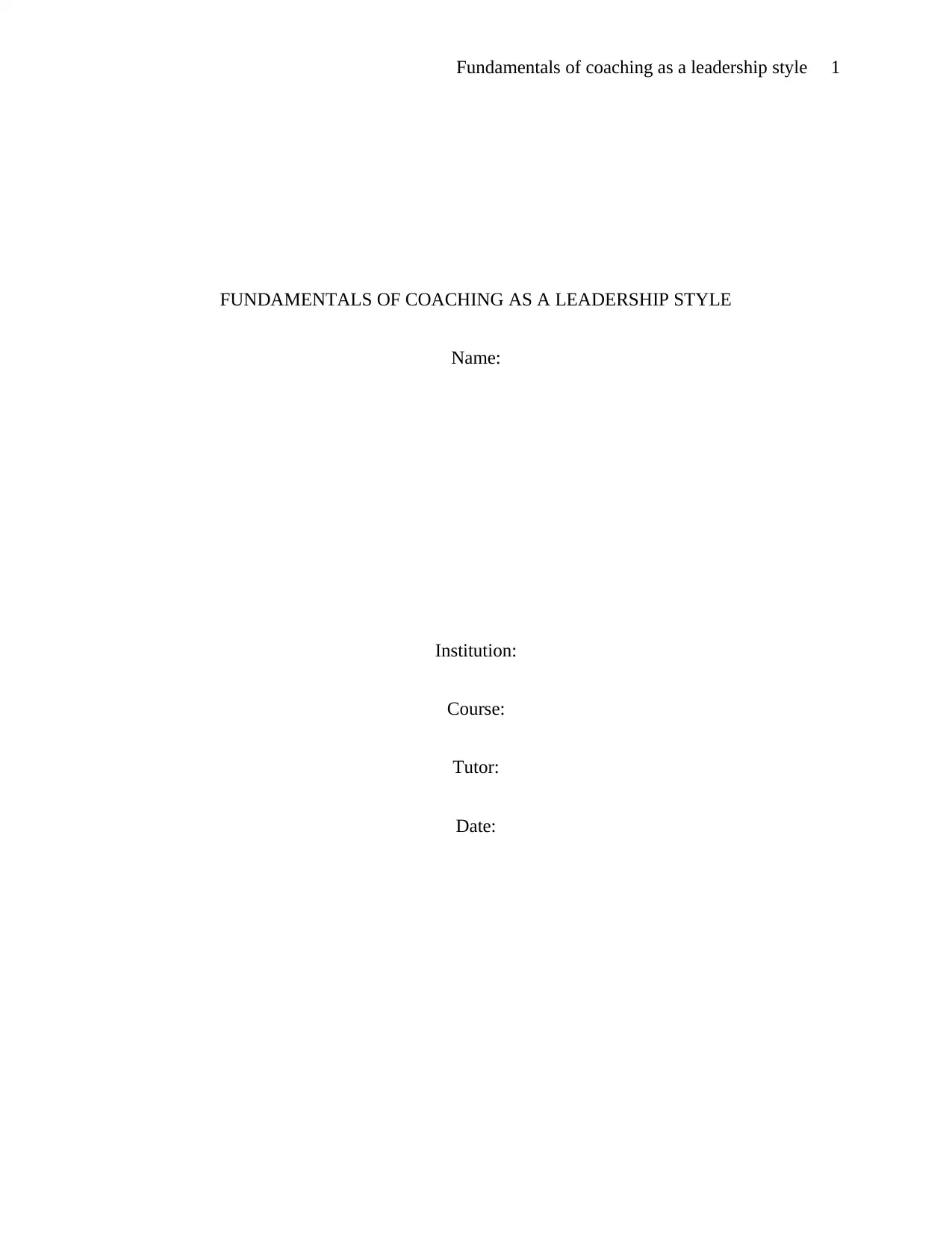
Fundamentals of coaching as a leadership style 1
FUNDAMENTALS OF COACHING AS A LEADERSHIP STYLE
Name:
Institution:
Course:
Tutor:
Date:
FUNDAMENTALS OF COACHING AS A LEADERSHIP STYLE
Name:
Institution:
Course:
Tutor:
Date:
Paraphrase This Document
Need a fresh take? Get an instant paraphrase of this document with our AI Paraphraser
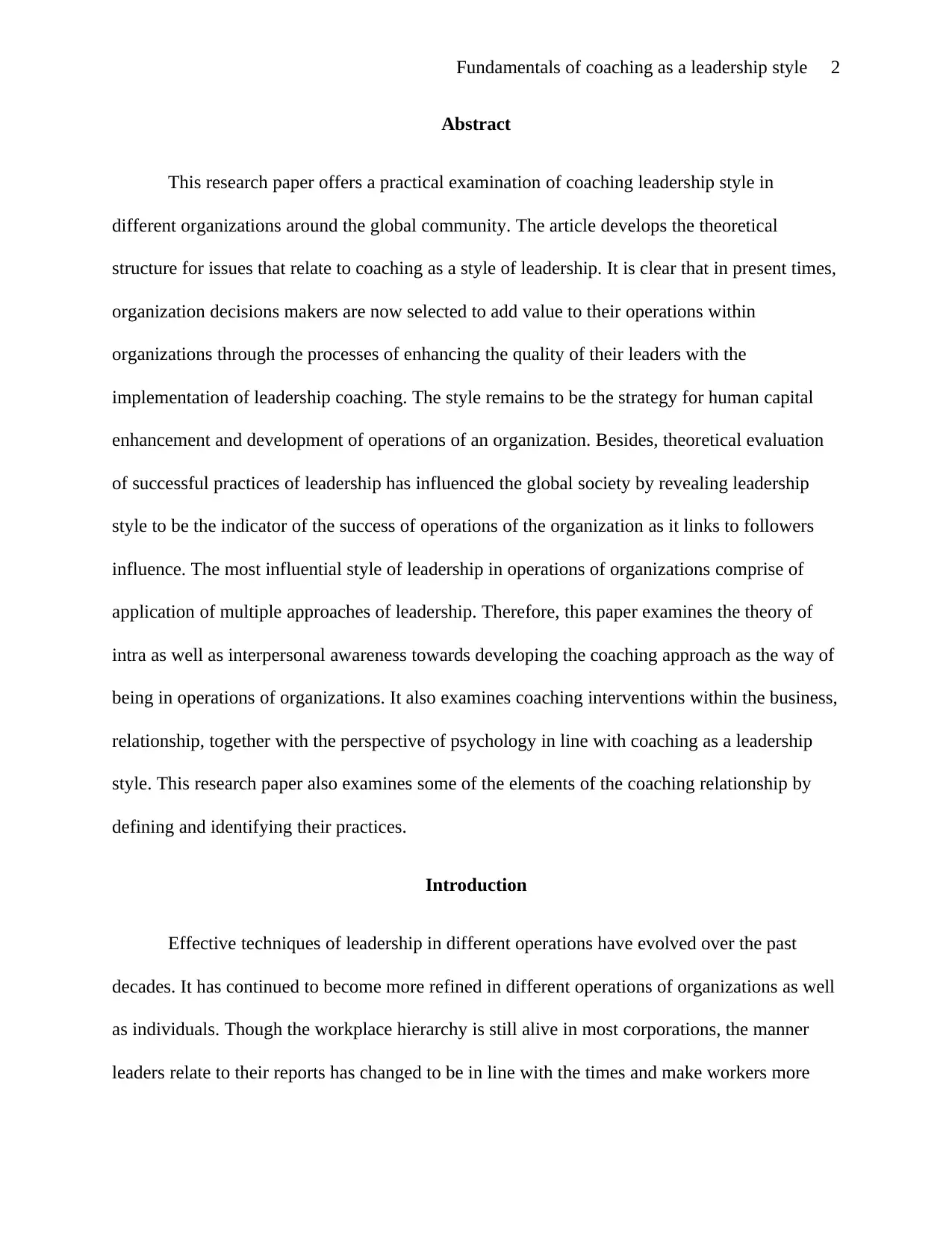
Fundamentals of coaching as a leadership style 2
Abstract
This research paper offers a practical examination of coaching leadership style in
different organizations around the global community. The article develops the theoretical
structure for issues that relate to coaching as a style of leadership. It is clear that in present times,
organization decisions makers are now selected to add value to their operations within
organizations through the processes of enhancing the quality of their leaders with the
implementation of leadership coaching. The style remains to be the strategy for human capital
enhancement and development of operations of an organization. Besides, theoretical evaluation
of successful practices of leadership has influenced the global society by revealing leadership
style to be the indicator of the success of operations of the organization as it links to followers
influence. The most influential style of leadership in operations of organizations comprise of
application of multiple approaches of leadership. Therefore, this paper examines the theory of
intra as well as interpersonal awareness towards developing the coaching approach as the way of
being in operations of organizations. It also examines coaching interventions within the business,
relationship, together with the perspective of psychology in line with coaching as a leadership
style. This research paper also examines some of the elements of the coaching relationship by
defining and identifying their practices.
Introduction
Effective techniques of leadership in different operations have evolved over the past
decades. It has continued to become more refined in different operations of organizations as well
as individuals. Though the workplace hierarchy is still alive in most corporations, the manner
leaders relate to their reports has changed to be in line with the times and make workers more
Abstract
This research paper offers a practical examination of coaching leadership style in
different organizations around the global community. The article develops the theoretical
structure for issues that relate to coaching as a style of leadership. It is clear that in present times,
organization decisions makers are now selected to add value to their operations within
organizations through the processes of enhancing the quality of their leaders with the
implementation of leadership coaching. The style remains to be the strategy for human capital
enhancement and development of operations of an organization. Besides, theoretical evaluation
of successful practices of leadership has influenced the global society by revealing leadership
style to be the indicator of the success of operations of the organization as it links to followers
influence. The most influential style of leadership in operations of organizations comprise of
application of multiple approaches of leadership. Therefore, this paper examines the theory of
intra as well as interpersonal awareness towards developing the coaching approach as the way of
being in operations of organizations. It also examines coaching interventions within the business,
relationship, together with the perspective of psychology in line with coaching as a leadership
style. This research paper also examines some of the elements of the coaching relationship by
defining and identifying their practices.
Introduction
Effective techniques of leadership in different operations have evolved over the past
decades. It has continued to become more refined in different operations of organizations as well
as individuals. Though the workplace hierarchy is still alive in most corporations, the manner
leaders relate to their reports has changed to be in line with the times and make workers more
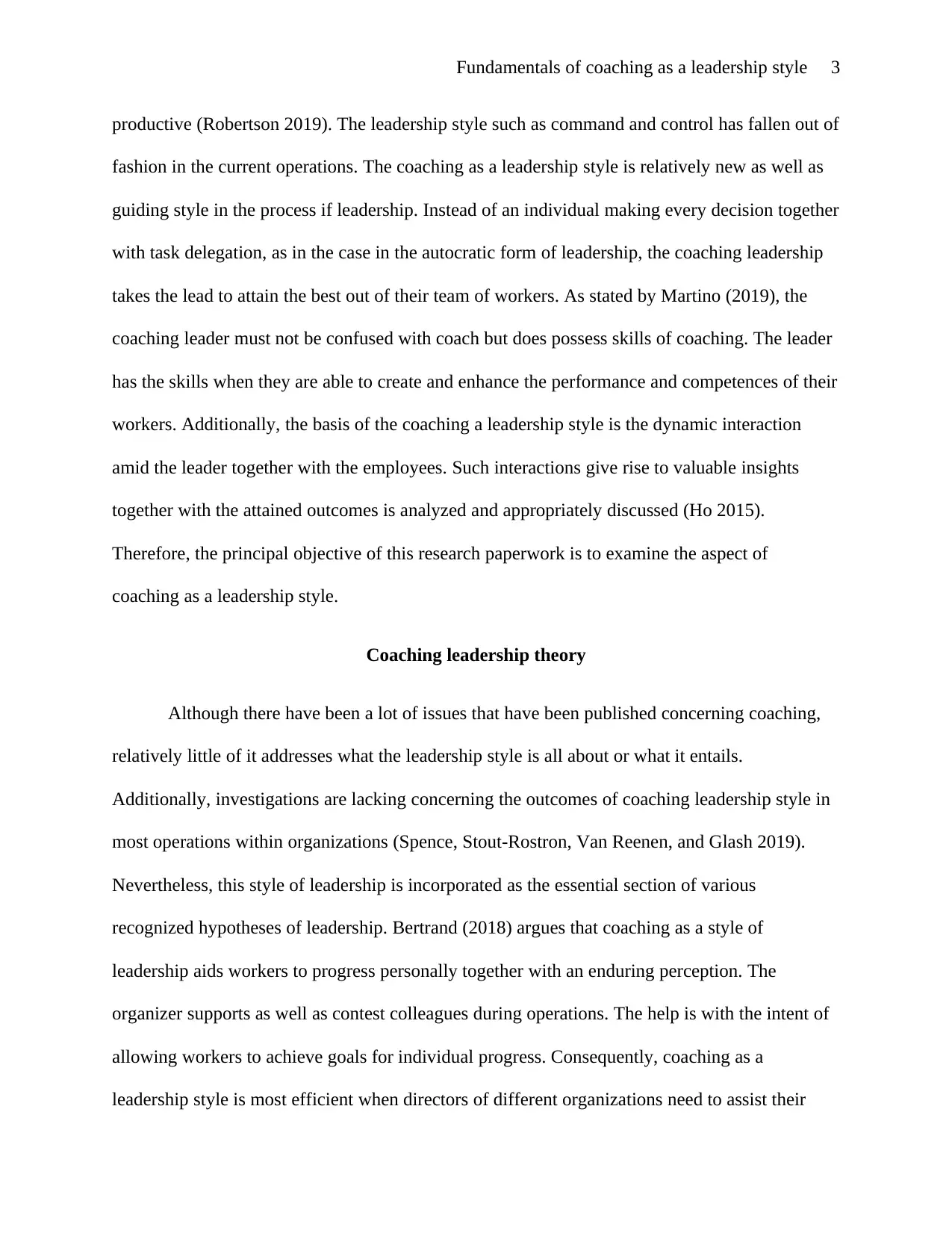
Fundamentals of coaching as a leadership style 3
productive (Robertson 2019). The leadership style such as command and control has fallen out of
fashion in the current operations. The coaching as a leadership style is relatively new as well as
guiding style in the process if leadership. Instead of an individual making every decision together
with task delegation, as in the case in the autocratic form of leadership, the coaching leadership
takes the lead to attain the best out of their team of workers. As stated by Martino (2019), the
coaching leader must not be confused with coach but does possess skills of coaching. The leader
has the skills when they are able to create and enhance the performance and competences of their
workers. Additionally, the basis of the coaching a leadership style is the dynamic interaction
amid the leader together with the employees. Such interactions give rise to valuable insights
together with the attained outcomes is analyzed and appropriately discussed (Ho 2015).
Therefore, the principal objective of this research paperwork is to examine the aspect of
coaching as a leadership style.
Coaching leadership theory
Although there have been a lot of issues that have been published concerning coaching,
relatively little of it addresses what the leadership style is all about or what it entails.
Additionally, investigations are lacking concerning the outcomes of coaching leadership style in
most operations within organizations (Spence, Stout-Rostron, Van Reenen, and Glash 2019).
Nevertheless, this style of leadership is incorporated as the essential section of various
recognized hypotheses of leadership. Bertrand (2018) argues that coaching as a style of
leadership aids workers to progress personally together with an enduring perception. The
organizer supports as well as contest colleagues during operations. The help is with the intent of
allowing workers to achieve goals for individual progress. Consequently, coaching as a
leadership style is most efficient when directors of different organizations need to assist their
productive (Robertson 2019). The leadership style such as command and control has fallen out of
fashion in the current operations. The coaching as a leadership style is relatively new as well as
guiding style in the process if leadership. Instead of an individual making every decision together
with task delegation, as in the case in the autocratic form of leadership, the coaching leadership
takes the lead to attain the best out of their team of workers. As stated by Martino (2019), the
coaching leader must not be confused with coach but does possess skills of coaching. The leader
has the skills when they are able to create and enhance the performance and competences of their
workers. Additionally, the basis of the coaching a leadership style is the dynamic interaction
amid the leader together with the employees. Such interactions give rise to valuable insights
together with the attained outcomes is analyzed and appropriately discussed (Ho 2015).
Therefore, the principal objective of this research paperwork is to examine the aspect of
coaching as a leadership style.
Coaching leadership theory
Although there have been a lot of issues that have been published concerning coaching,
relatively little of it addresses what the leadership style is all about or what it entails.
Additionally, investigations are lacking concerning the outcomes of coaching leadership style in
most operations within organizations (Spence, Stout-Rostron, Van Reenen, and Glash 2019).
Nevertheless, this style of leadership is incorporated as the essential section of various
recognized hypotheses of leadership. Bertrand (2018) argues that coaching as a style of
leadership aids workers to progress personally together with an enduring perception. The
organizer supports as well as contest colleagues during operations. The help is with the intent of
allowing workers to achieve goals for individual progress. Consequently, coaching as a
leadership style is most efficient when directors of different organizations need to assist their
⊘ This is a preview!⊘
Do you want full access?
Subscribe today to unlock all pages.

Trusted by 1+ million students worldwide
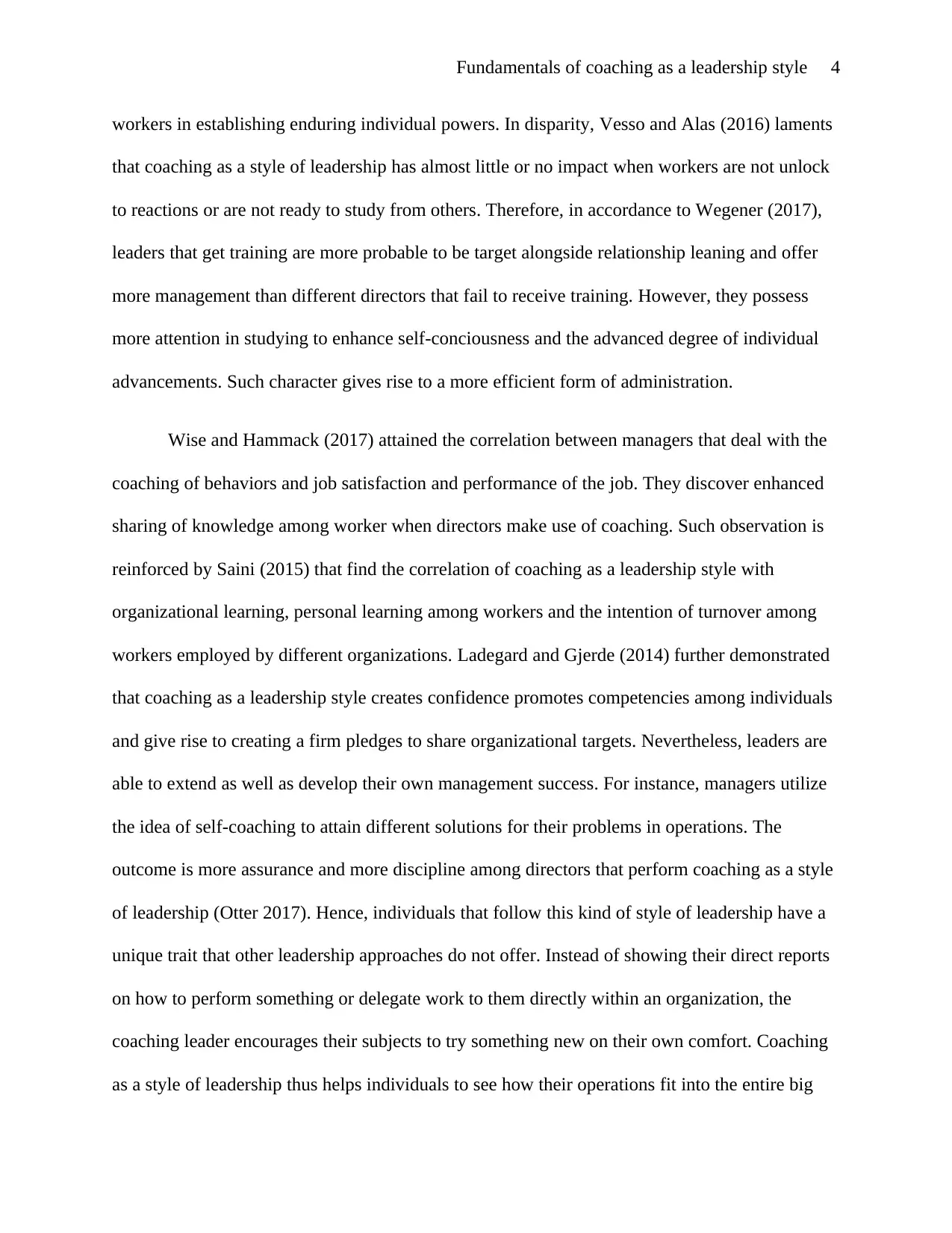
Fundamentals of coaching as a leadership style 4
workers in establishing enduring individual powers. In disparity, Vesso and Alas (2016) laments
that coaching as a style of leadership has almost little or no impact when workers are not unlock
to reactions or are not ready to study from others. Therefore, in accordance to Wegener (2017),
leaders that get training are more probable to be target alongside relationship leaning and offer
more management than different directors that fail to receive training. However, they possess
more attention in studying to enhance self-conciousness and the advanced degree of individual
advancements. Such character gives rise to a more efficient form of administration.
Wise and Hammack (2017) attained the correlation between managers that deal with the
coaching of behaviors and job satisfaction and performance of the job. They discover enhanced
sharing of knowledge among worker when directors make use of coaching. Such observation is
reinforced by Saini (2015) that find the correlation of coaching as a leadership style with
organizational learning, personal learning among workers and the intention of turnover among
workers employed by different organizations. Ladegard and Gjerde (2014) further demonstrated
that coaching as a leadership style creates confidence promotes competencies among individuals
and give rise to creating a firm pledges to share organizational targets. Nevertheless, leaders are
able to extend as well as develop their own management success. For instance, managers utilize
the idea of self-coaching to attain different solutions for their problems in operations. The
outcome is more assurance and more discipline among directors that perform coaching as a style
of leadership (Otter 2017). Hence, individuals that follow this kind of style of leadership have a
unique trait that other leadership approaches do not offer. Instead of showing their direct reports
on how to perform something or delegate work to them directly within an organization, the
coaching leader encourages their subjects to try something new on their own comfort. Coaching
as a style of leadership thus helps individuals to see how their operations fit into the entire big
workers in establishing enduring individual powers. In disparity, Vesso and Alas (2016) laments
that coaching as a style of leadership has almost little or no impact when workers are not unlock
to reactions or are not ready to study from others. Therefore, in accordance to Wegener (2017),
leaders that get training are more probable to be target alongside relationship leaning and offer
more management than different directors that fail to receive training. However, they possess
more attention in studying to enhance self-conciousness and the advanced degree of individual
advancements. Such character gives rise to a more efficient form of administration.
Wise and Hammack (2017) attained the correlation between managers that deal with the
coaching of behaviors and job satisfaction and performance of the job. They discover enhanced
sharing of knowledge among worker when directors make use of coaching. Such observation is
reinforced by Saini (2015) that find the correlation of coaching as a leadership style with
organizational learning, personal learning among workers and the intention of turnover among
workers employed by different organizations. Ladegard and Gjerde (2014) further demonstrated
that coaching as a leadership style creates confidence promotes competencies among individuals
and give rise to creating a firm pledges to share organizational targets. Nevertheless, leaders are
able to extend as well as develop their own management success. For instance, managers utilize
the idea of self-coaching to attain different solutions for their problems in operations. The
outcome is more assurance and more discipline among directors that perform coaching as a style
of leadership (Otter 2017). Hence, individuals that follow this kind of style of leadership have a
unique trait that other leadership approaches do not offer. Instead of showing their direct reports
on how to perform something or delegate work to them directly within an organization, the
coaching leader encourages their subjects to try something new on their own comfort. Coaching
as a style of leadership thus helps individuals to see how their operations fit into the entire big
Paraphrase This Document
Need a fresh take? Get an instant paraphrase of this document with our AI Paraphraser
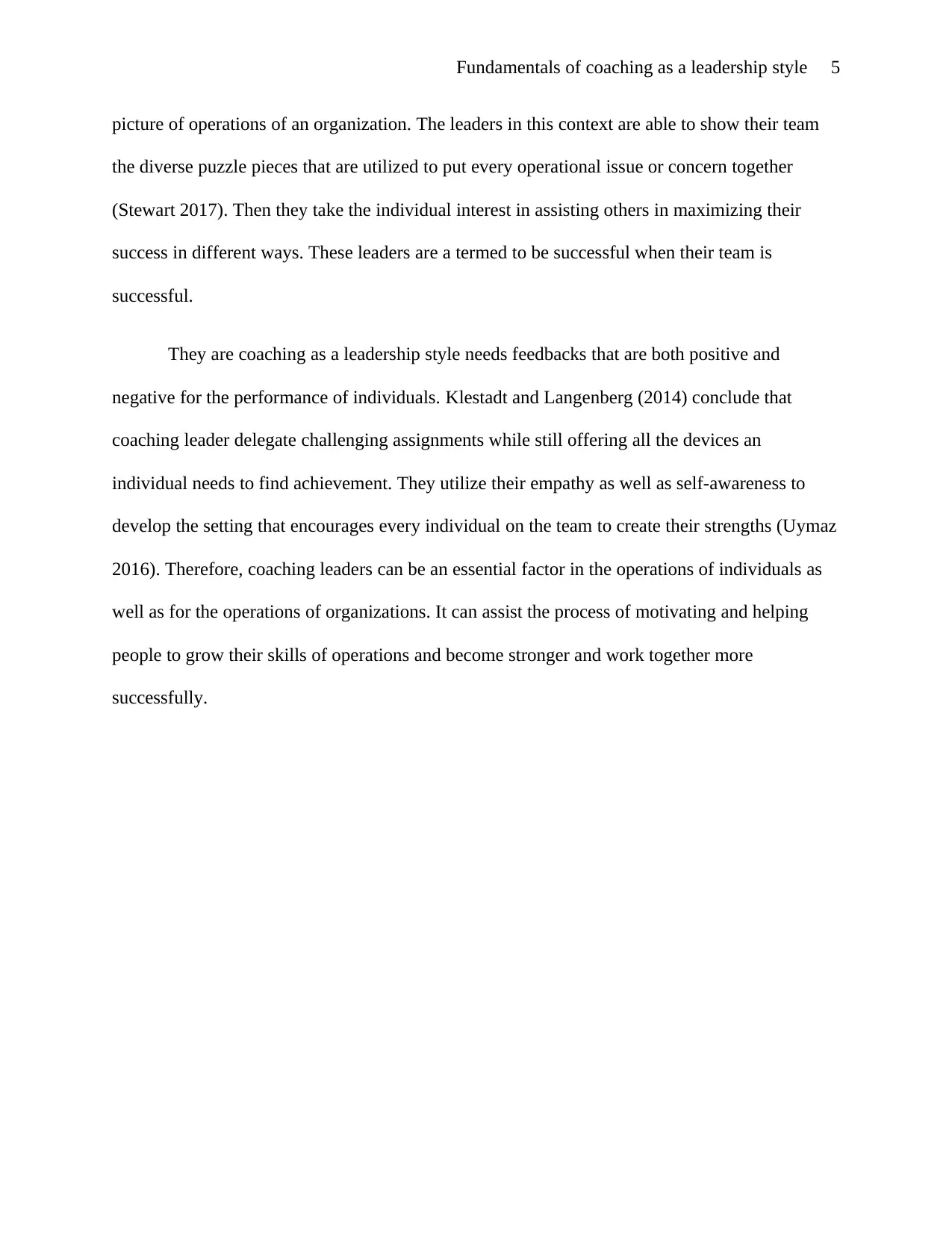
Fundamentals of coaching as a leadership style 5
picture of operations of an organization. The leaders in this context are able to show their team
the diverse puzzle pieces that are utilized to put every operational issue or concern together
(Stewart 2017). Then they take the individual interest in assisting others in maximizing their
success in different ways. These leaders are a termed to be successful when their team is
successful.
They are coaching as a leadership style needs feedbacks that are both positive and
negative for the performance of individuals. Klestadt and Langenberg (2014) conclude that
coaching leader delegate challenging assignments while still offering all the devices an
individual needs to find achievement. They utilize their empathy as well as self-awareness to
develop the setting that encourages every individual on the team to create their strengths (Uymaz
2016). Therefore, coaching leaders can be an essential factor in the operations of individuals as
well as for the operations of organizations. It can assist the process of motivating and helping
people to grow their skills of operations and become stronger and work together more
successfully.
picture of operations of an organization. The leaders in this context are able to show their team
the diverse puzzle pieces that are utilized to put every operational issue or concern together
(Stewart 2017). Then they take the individual interest in assisting others in maximizing their
success in different ways. These leaders are a termed to be successful when their team is
successful.
They are coaching as a leadership style needs feedbacks that are both positive and
negative for the performance of individuals. Klestadt and Langenberg (2014) conclude that
coaching leader delegate challenging assignments while still offering all the devices an
individual needs to find achievement. They utilize their empathy as well as self-awareness to
develop the setting that encourages every individual on the team to create their strengths (Uymaz
2016). Therefore, coaching leaders can be an essential factor in the operations of individuals as
well as for the operations of organizations. It can assist the process of motivating and helping
people to grow their skills of operations and become stronger and work together more
successfully.
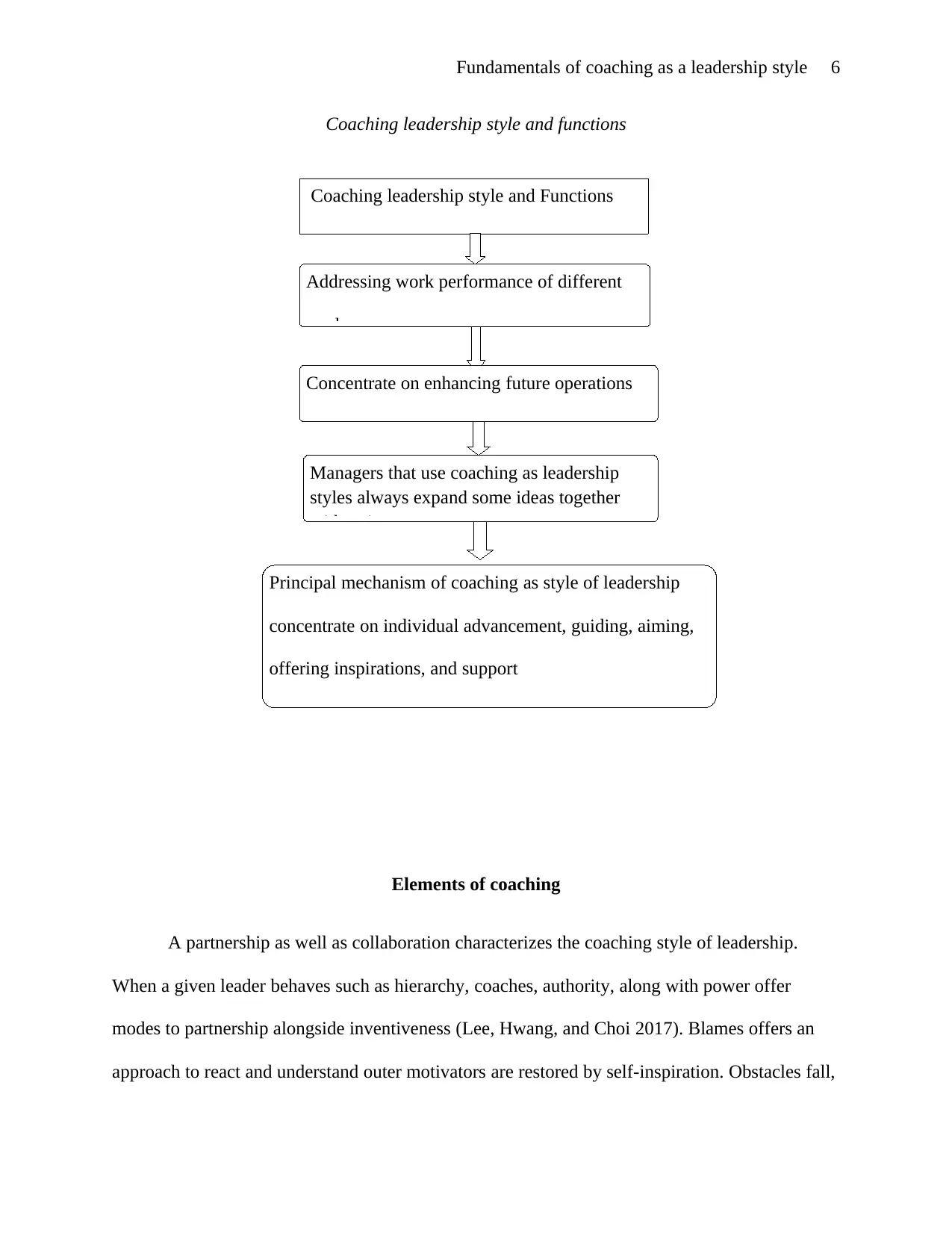
Fundamentals of coaching as a leadership style 6
Coaching leadership style and functions
Elements of coaching
A partnership as well as collaboration characterizes the coaching style of leadership.
When a given leader behaves such as hierarchy, coaches, authority, along with power offer
modes to partnership alongside inventiveness (Lee, Hwang, and Choi 2017). Blames offers an
approach to react and understand outer motivators are restored by self-inspiration. Obstacles fall,
Coaching leadership style and Functions
Addressing work performance of different
workers
Concentrate on enhancing future operations
Managers that use coaching as leadership
styles always expand some ideas together
with traits
Principal mechanism of coaching as style of leadership
concentrate on individual advancement, guiding, aiming,
offering inspirations, and support
Coaching leadership style and functions
Elements of coaching
A partnership as well as collaboration characterizes the coaching style of leadership.
When a given leader behaves such as hierarchy, coaches, authority, along with power offer
modes to partnership alongside inventiveness (Lee, Hwang, and Choi 2017). Blames offers an
approach to react and understand outer motivators are restored by self-inspiration. Obstacles fall,
Coaching leadership style and Functions
Addressing work performance of different
workers
Concentrate on enhancing future operations
Managers that use coaching as leadership
styles always expand some ideas together
with traits
Principal mechanism of coaching as style of leadership
concentrate on individual advancement, guiding, aiming,
offering inspirations, and support
⊘ This is a preview!⊘
Do you want full access?
Subscribe today to unlock all pages.

Trusted by 1+ million students worldwide
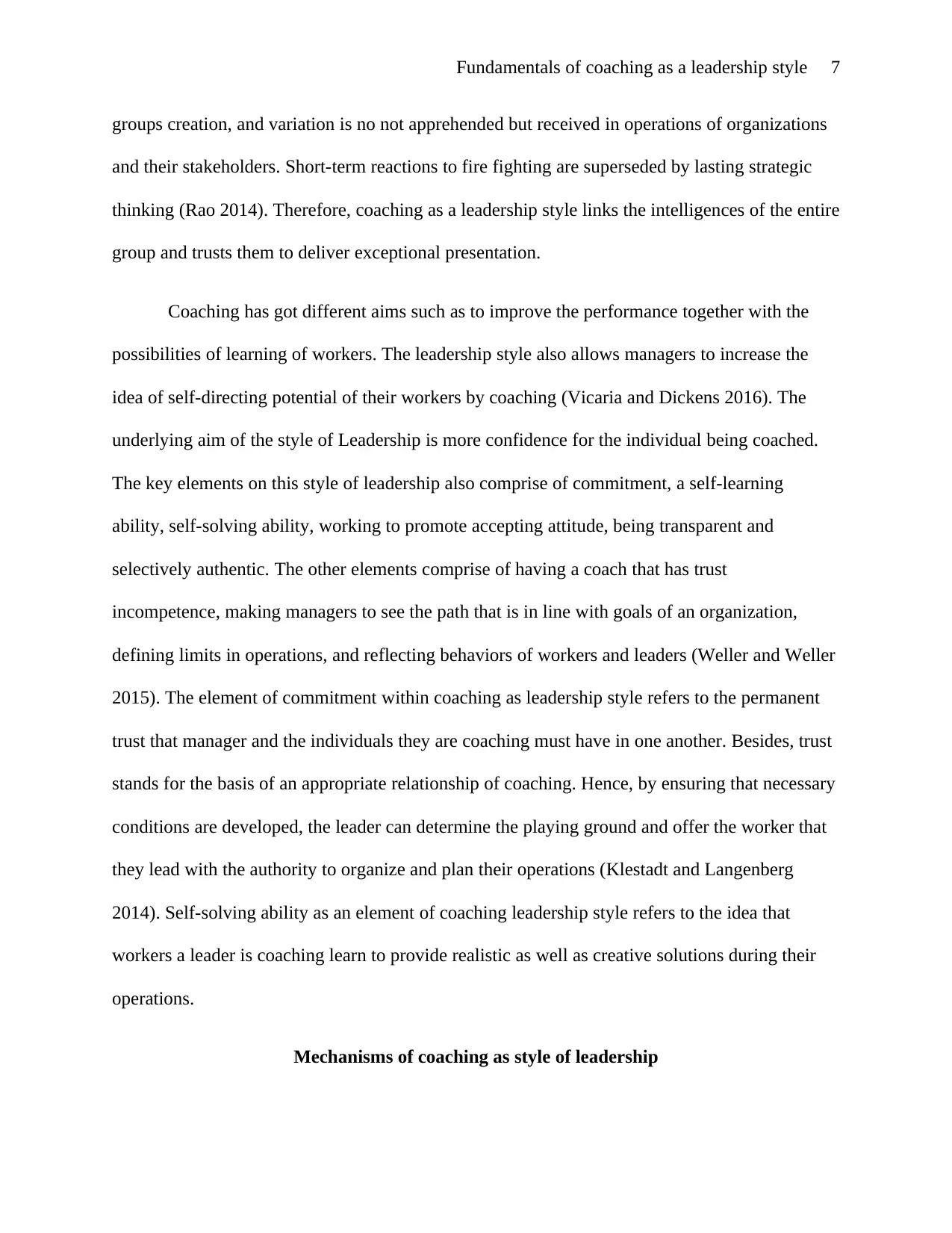
Fundamentals of coaching as a leadership style 7
groups creation, and variation is no not apprehended but received in operations of organizations
and their stakeholders. Short-term reactions to fire fighting are superseded by lasting strategic
thinking (Rao 2014). Therefore, coaching as a leadership style links the intelligences of the entire
group and trusts them to deliver exceptional presentation.
Coaching has got different aims such as to improve the performance together with the
possibilities of learning of workers. The leadership style also allows managers to increase the
idea of self-directing potential of their workers by coaching (Vicaria and Dickens 2016). The
underlying aim of the style of Leadership is more confidence for the individual being coached.
The key elements on this style of leadership also comprise of commitment, a self-learning
ability, self-solving ability, working to promote accepting attitude, being transparent and
selectively authentic. The other elements comprise of having a coach that has trust
incompetence, making managers to see the path that is in line with goals of an organization,
defining limits in operations, and reflecting behaviors of workers and leaders (Weller and Weller
2015). The element of commitment within coaching as leadership style refers to the permanent
trust that manager and the individuals they are coaching must have in one another. Besides, trust
stands for the basis of an appropriate relationship of coaching. Hence, by ensuring that necessary
conditions are developed, the leader can determine the playing ground and offer the worker that
they lead with the authority to organize and plan their operations (Klestadt and Langenberg
2014). Self-solving ability as an element of coaching leadership style refers to the idea that
workers a leader is coaching learn to provide realistic as well as creative solutions during their
operations.
Mechanisms of coaching as style of leadership
groups creation, and variation is no not apprehended but received in operations of organizations
and their stakeholders. Short-term reactions to fire fighting are superseded by lasting strategic
thinking (Rao 2014). Therefore, coaching as a leadership style links the intelligences of the entire
group and trusts them to deliver exceptional presentation.
Coaching has got different aims such as to improve the performance together with the
possibilities of learning of workers. The leadership style also allows managers to increase the
idea of self-directing potential of their workers by coaching (Vicaria and Dickens 2016). The
underlying aim of the style of Leadership is more confidence for the individual being coached.
The key elements on this style of leadership also comprise of commitment, a self-learning
ability, self-solving ability, working to promote accepting attitude, being transparent and
selectively authentic. The other elements comprise of having a coach that has trust
incompetence, making managers to see the path that is in line with goals of an organization,
defining limits in operations, and reflecting behaviors of workers and leaders (Weller and Weller
2015). The element of commitment within coaching as leadership style refers to the permanent
trust that manager and the individuals they are coaching must have in one another. Besides, trust
stands for the basis of an appropriate relationship of coaching. Hence, by ensuring that necessary
conditions are developed, the leader can determine the playing ground and offer the worker that
they lead with the authority to organize and plan their operations (Klestadt and Langenberg
2014). Self-solving ability as an element of coaching leadership style refers to the idea that
workers a leader is coaching learn to provide realistic as well as creative solutions during their
operations.
Mechanisms of coaching as style of leadership
Paraphrase This Document
Need a fresh take? Get an instant paraphrase of this document with our AI Paraphraser
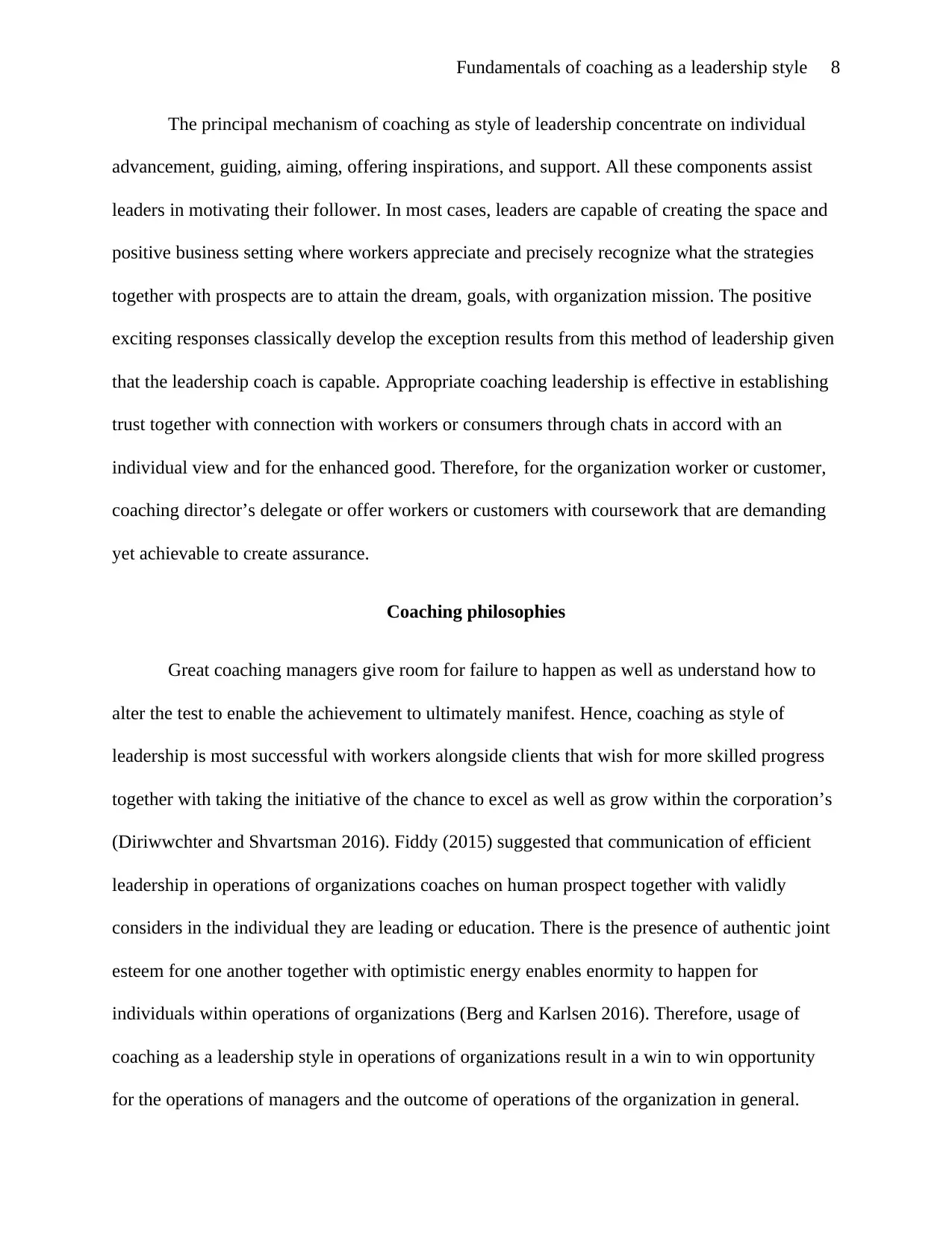
Fundamentals of coaching as a leadership style 8
The principal mechanism of coaching as style of leadership concentrate on individual
advancement, guiding, aiming, offering inspirations, and support. All these components assist
leaders in motivating their follower. In most cases, leaders are capable of creating the space and
positive business setting where workers appreciate and precisely recognize what the strategies
together with prospects are to attain the dream, goals, with organization mission. The positive
exciting responses classically develop the exception results from this method of leadership given
that the leadership coach is capable. Appropriate coaching leadership is effective in establishing
trust together with connection with workers or consumers through chats in accord with an
individual view and for the enhanced good. Therefore, for the organization worker or customer,
coaching director’s delegate or offer workers or customers with coursework that are demanding
yet achievable to create assurance.
Coaching philosophies
Great coaching managers give room for failure to happen as well as understand how to
alter the test to enable the achievement to ultimately manifest. Hence, coaching as style of
leadership is most successful with workers alongside clients that wish for more skilled progress
together with taking the initiative of the chance to excel as well as grow within the corporation’s
(Diriwwchter and Shvartsman 2016). Fiddy (2015) suggested that communication of efficient
leadership in operations of organizations coaches on human prospect together with validly
considers in the individual they are leading or education. There is the presence of authentic joint
esteem for one another together with optimistic energy enables enormity to happen for
individuals within operations of organizations (Berg and Karlsen 2016). Therefore, usage of
coaching as a leadership style in operations of organizations result in a win to win opportunity
for the operations of managers and the outcome of operations of the organization in general.
The principal mechanism of coaching as style of leadership concentrate on individual
advancement, guiding, aiming, offering inspirations, and support. All these components assist
leaders in motivating their follower. In most cases, leaders are capable of creating the space and
positive business setting where workers appreciate and precisely recognize what the strategies
together with prospects are to attain the dream, goals, with organization mission. The positive
exciting responses classically develop the exception results from this method of leadership given
that the leadership coach is capable. Appropriate coaching leadership is effective in establishing
trust together with connection with workers or consumers through chats in accord with an
individual view and for the enhanced good. Therefore, for the organization worker or customer,
coaching director’s delegate or offer workers or customers with coursework that are demanding
yet achievable to create assurance.
Coaching philosophies
Great coaching managers give room for failure to happen as well as understand how to
alter the test to enable the achievement to ultimately manifest. Hence, coaching as style of
leadership is most successful with workers alongside clients that wish for more skilled progress
together with taking the initiative of the chance to excel as well as grow within the corporation’s
(Diriwwchter and Shvartsman 2016). Fiddy (2015) suggested that communication of efficient
leadership in operations of organizations coaches on human prospect together with validly
considers in the individual they are leading or education. There is the presence of authentic joint
esteem for one another together with optimistic energy enables enormity to happen for
individuals within operations of organizations (Berg and Karlsen 2016). Therefore, usage of
coaching as a leadership style in operations of organizations result in a win to win opportunity
for the operations of managers and the outcome of operations of the organization in general.
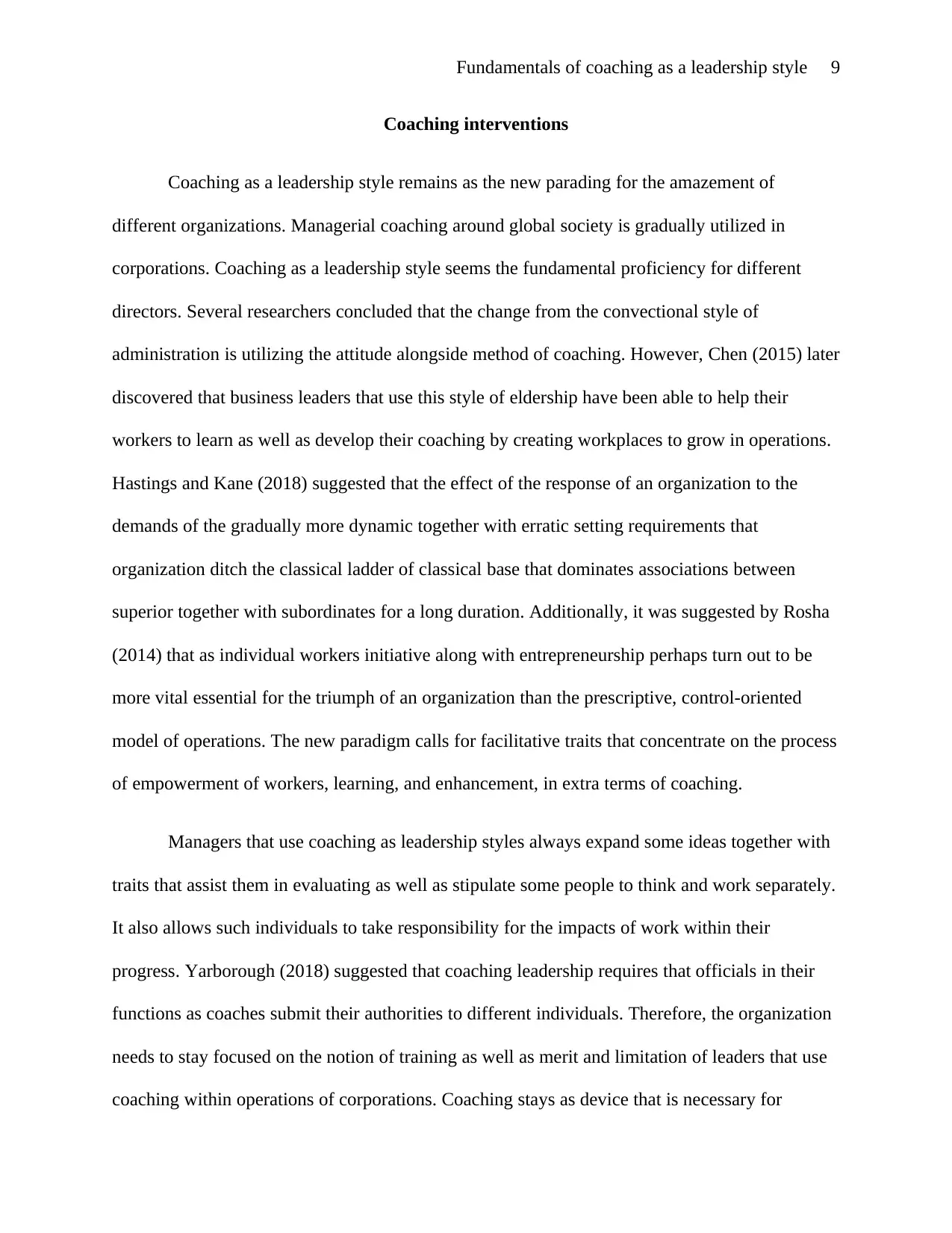
Fundamentals of coaching as a leadership style 9
Coaching interventions
Coaching as a leadership style remains as the new parading for the amazement of
different organizations. Managerial coaching around global society is gradually utilized in
corporations. Coaching as a leadership style seems the fundamental proficiency for different
directors. Several researchers concluded that the change from the convectional style of
administration is utilizing the attitude alongside method of coaching. However, Chen (2015) later
discovered that business leaders that use this style of eldership have been able to help their
workers to learn as well as develop their coaching by creating workplaces to grow in operations.
Hastings and Kane (2018) suggested that the effect of the response of an organization to the
demands of the gradually more dynamic together with erratic setting requirements that
organization ditch the classical ladder of classical base that dominates associations between
superior together with subordinates for a long duration. Additionally, it was suggested by Rosha
(2014) that as individual workers initiative along with entrepreneurship perhaps turn out to be
more vital essential for the triumph of an organization than the prescriptive, control-oriented
model of operations. The new paradigm calls for facilitative traits that concentrate on the process
of empowerment of workers, learning, and enhancement, in extra terms of coaching.
Managers that use coaching as leadership styles always expand some ideas together with
traits that assist them in evaluating as well as stipulate some people to think and work separately.
It also allows such individuals to take responsibility for the impacts of work within their
progress. Yarborough (2018) suggested that coaching leadership requires that officials in their
functions as coaches submit their authorities to different individuals. Therefore, the organization
needs to stay focused on the notion of training as well as merit and limitation of leaders that use
coaching within operations of corporations. Coaching stays as device that is necessary for
Coaching interventions
Coaching as a leadership style remains as the new parading for the amazement of
different organizations. Managerial coaching around global society is gradually utilized in
corporations. Coaching as a leadership style seems the fundamental proficiency for different
directors. Several researchers concluded that the change from the convectional style of
administration is utilizing the attitude alongside method of coaching. However, Chen (2015) later
discovered that business leaders that use this style of eldership have been able to help their
workers to learn as well as develop their coaching by creating workplaces to grow in operations.
Hastings and Kane (2018) suggested that the effect of the response of an organization to the
demands of the gradually more dynamic together with erratic setting requirements that
organization ditch the classical ladder of classical base that dominates associations between
superior together with subordinates for a long duration. Additionally, it was suggested by Rosha
(2014) that as individual workers initiative along with entrepreneurship perhaps turn out to be
more vital essential for the triumph of an organization than the prescriptive, control-oriented
model of operations. The new paradigm calls for facilitative traits that concentrate on the process
of empowerment of workers, learning, and enhancement, in extra terms of coaching.
Managers that use coaching as leadership styles always expand some ideas together with
traits that assist them in evaluating as well as stipulate some people to think and work separately.
It also allows such individuals to take responsibility for the impacts of work within their
progress. Yarborough (2018) suggested that coaching leadership requires that officials in their
functions as coaches submit their authorities to different individuals. Therefore, the organization
needs to stay focused on the notion of training as well as merit and limitation of leaders that use
coaching within operations of corporations. Coaching stays as device that is necessary for
⊘ This is a preview!⊘
Do you want full access?
Subscribe today to unlock all pages.

Trusted by 1+ million students worldwide
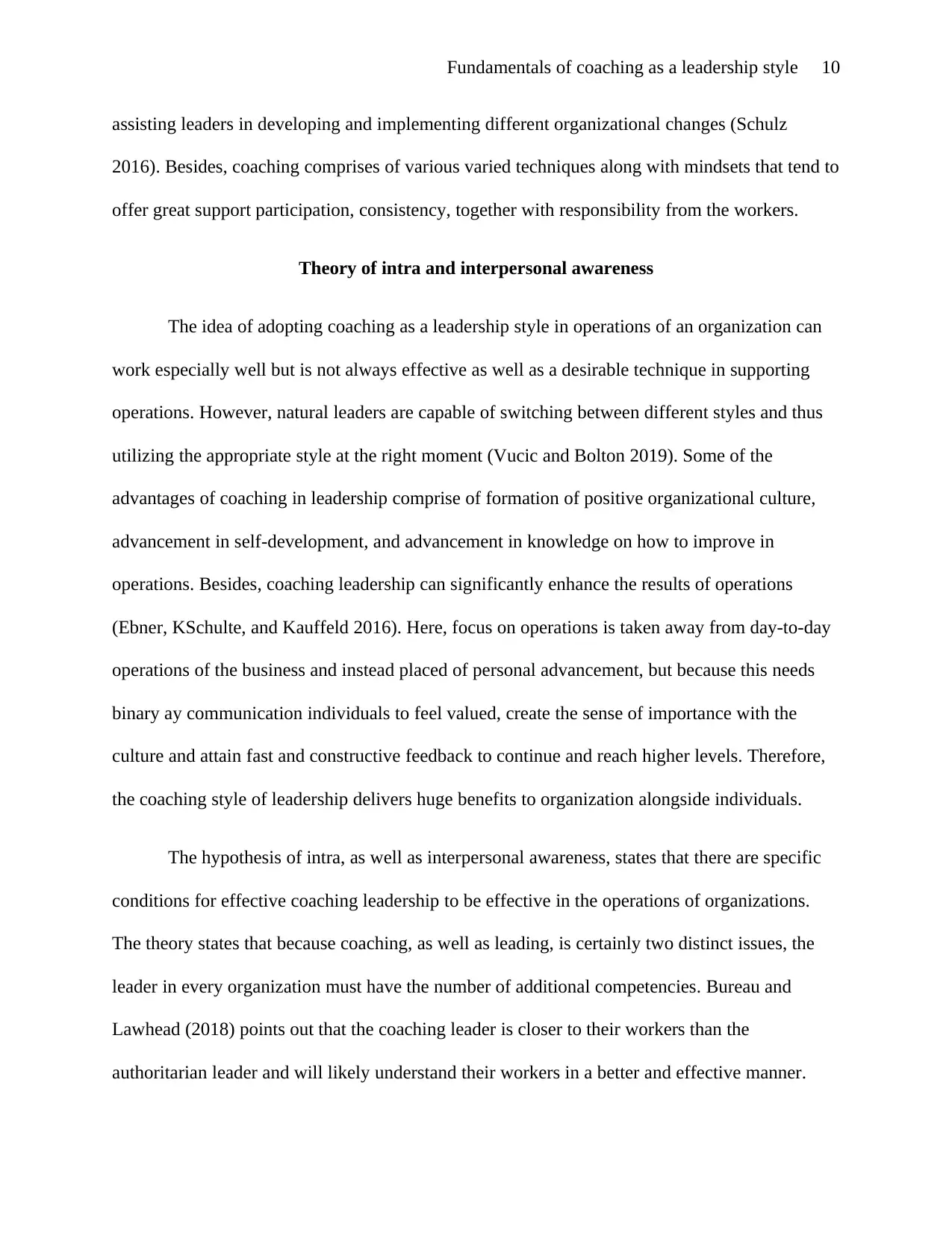
Fundamentals of coaching as a leadership style 10
assisting leaders in developing and implementing different organizational changes (Schulz
2016). Besides, coaching comprises of various varied techniques along with mindsets that tend to
offer great support participation, consistency, together with responsibility from the workers.
Theory of intra and interpersonal awareness
The idea of adopting coaching as a leadership style in operations of an organization can
work especially well but is not always effective as well as a desirable technique in supporting
operations. However, natural leaders are capable of switching between different styles and thus
utilizing the appropriate style at the right moment (Vucic and Bolton 2019). Some of the
advantages of coaching in leadership comprise of formation of positive organizational culture,
advancement in self-development, and advancement in knowledge on how to improve in
operations. Besides, coaching leadership can significantly enhance the results of operations
(Ebner, KSchulte, and Kauffeld 2016). Here, focus on operations is taken away from day-to-day
operations of the business and instead placed of personal advancement, but because this needs
binary ay communication individuals to feel valued, create the sense of importance with the
culture and attain fast and constructive feedback to continue and reach higher levels. Therefore,
the coaching style of leadership delivers huge benefits to organization alongside individuals.
The hypothesis of intra, as well as interpersonal awareness, states that there are specific
conditions for effective coaching leadership to be effective in the operations of organizations.
The theory states that because coaching, as well as leading, is certainly two distinct issues, the
leader in every organization must have the number of additional competencies. Bureau and
Lawhead (2018) points out that the coaching leader is closer to their workers than the
authoritarian leader and will likely understand their workers in a better and effective manner.
assisting leaders in developing and implementing different organizational changes (Schulz
2016). Besides, coaching comprises of various varied techniques along with mindsets that tend to
offer great support participation, consistency, together with responsibility from the workers.
Theory of intra and interpersonal awareness
The idea of adopting coaching as a leadership style in operations of an organization can
work especially well but is not always effective as well as a desirable technique in supporting
operations. However, natural leaders are capable of switching between different styles and thus
utilizing the appropriate style at the right moment (Vucic and Bolton 2019). Some of the
advantages of coaching in leadership comprise of formation of positive organizational culture,
advancement in self-development, and advancement in knowledge on how to improve in
operations. Besides, coaching leadership can significantly enhance the results of operations
(Ebner, KSchulte, and Kauffeld 2016). Here, focus on operations is taken away from day-to-day
operations of the business and instead placed of personal advancement, but because this needs
binary ay communication individuals to feel valued, create the sense of importance with the
culture and attain fast and constructive feedback to continue and reach higher levels. Therefore,
the coaching style of leadership delivers huge benefits to organization alongside individuals.
The hypothesis of intra, as well as interpersonal awareness, states that there are specific
conditions for effective coaching leadership to be effective in the operations of organizations.
The theory states that because coaching, as well as leading, is certainly two distinct issues, the
leader in every organization must have the number of additional competencies. Bureau and
Lawhead (2018) points out that the coaching leader is closer to their workers than the
authoritarian leader and will likely understand their workers in a better and effective manner.
Paraphrase This Document
Need a fresh take? Get an instant paraphrase of this document with our AI Paraphraser
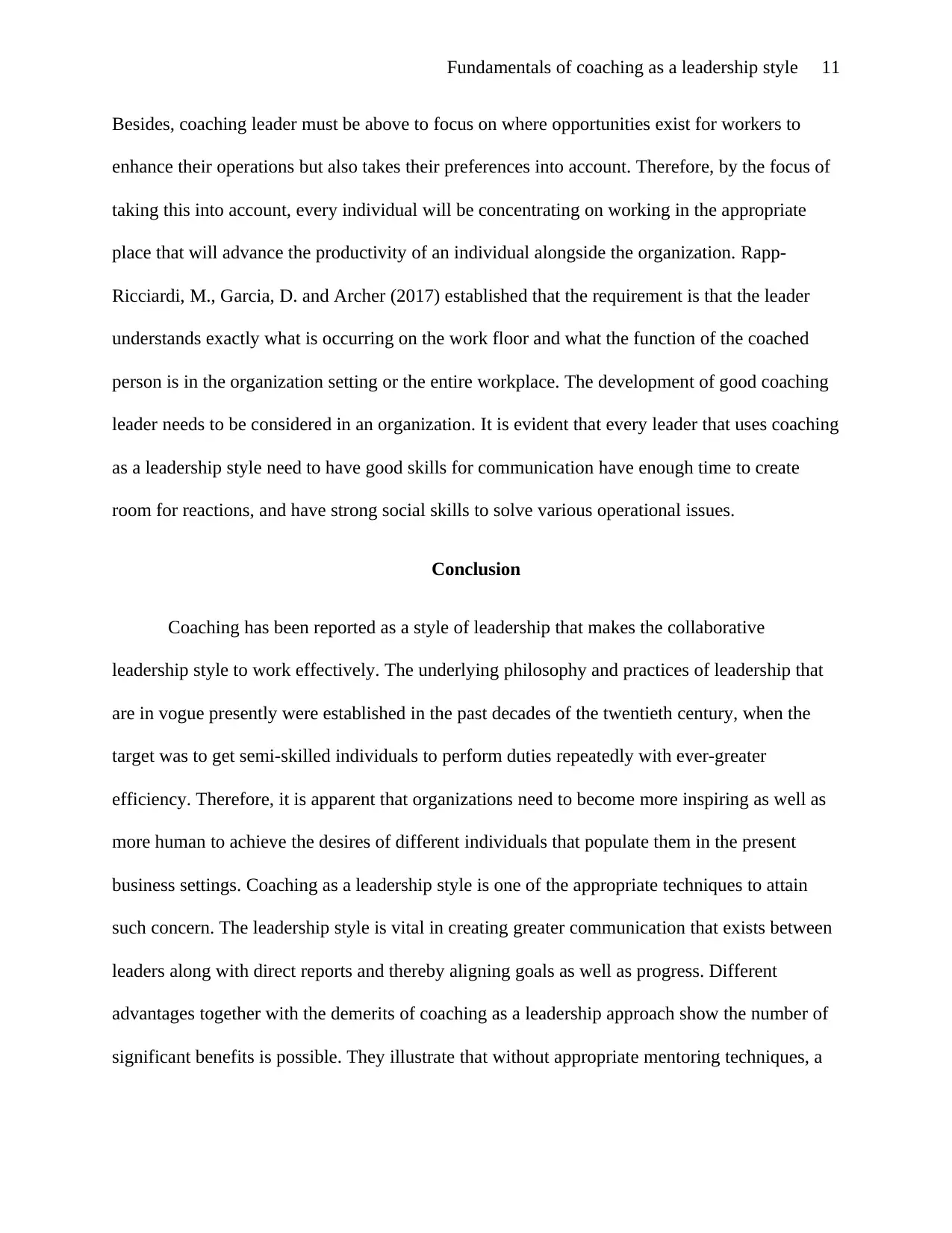
Fundamentals of coaching as a leadership style 11
Besides, coaching leader must be above to focus on where opportunities exist for workers to
enhance their operations but also takes their preferences into account. Therefore, by the focus of
taking this into account, every individual will be concentrating on working in the appropriate
place that will advance the productivity of an individual alongside the organization. Rapp-
Ricciardi, M., Garcia, D. and Archer (2017) established that the requirement is that the leader
understands exactly what is occurring on the work floor and what the function of the coached
person is in the organization setting or the entire workplace. The development of good coaching
leader needs to be considered in an organization. It is evident that every leader that uses coaching
as a leadership style need to have good skills for communication have enough time to create
room for reactions, and have strong social skills to solve various operational issues.
Conclusion
Coaching has been reported as a style of leadership that makes the collaborative
leadership style to work effectively. The underlying philosophy and practices of leadership that
are in vogue presently were established in the past decades of the twentieth century, when the
target was to get semi-skilled individuals to perform duties repeatedly with ever-greater
efficiency. Therefore, it is apparent that organizations need to become more inspiring as well as
more human to achieve the desires of different individuals that populate them in the present
business settings. Coaching as a leadership style is one of the appropriate techniques to attain
such concern. The leadership style is vital in creating greater communication that exists between
leaders along with direct reports and thereby aligning goals as well as progress. Different
advantages together with the demerits of coaching as a leadership approach show the number of
significant benefits is possible. They illustrate that without appropriate mentoring techniques, a
Besides, coaching leader must be above to focus on where opportunities exist for workers to
enhance their operations but also takes their preferences into account. Therefore, by the focus of
taking this into account, every individual will be concentrating on working in the appropriate
place that will advance the productivity of an individual alongside the organization. Rapp-
Ricciardi, M., Garcia, D. and Archer (2017) established that the requirement is that the leader
understands exactly what is occurring on the work floor and what the function of the coached
person is in the organization setting or the entire workplace. The development of good coaching
leader needs to be considered in an organization. It is evident that every leader that uses coaching
as a leadership style need to have good skills for communication have enough time to create
room for reactions, and have strong social skills to solve various operational issues.
Conclusion
Coaching has been reported as a style of leadership that makes the collaborative
leadership style to work effectively. The underlying philosophy and practices of leadership that
are in vogue presently were established in the past decades of the twentieth century, when the
target was to get semi-skilled individuals to perform duties repeatedly with ever-greater
efficiency. Therefore, it is apparent that organizations need to become more inspiring as well as
more human to achieve the desires of different individuals that populate them in the present
business settings. Coaching as a leadership style is one of the appropriate techniques to attain
such concern. The leadership style is vital in creating greater communication that exists between
leaders along with direct reports and thereby aligning goals as well as progress. Different
advantages together with the demerits of coaching as a leadership approach show the number of
significant benefits is possible. They illustrate that without appropriate mentoring techniques, a

Fundamentals of coaching as a leadership style 12
coaching leader will remain to be ineffective. There must be time and plenty of patience
available o allow for the formation of positive outcomes.
coaching leader will remain to be ineffective. There must be time and plenty of patience
available o allow for the formation of positive outcomes.
⊘ This is a preview!⊘
Do you want full access?
Subscribe today to unlock all pages.

Trusted by 1+ million students worldwide
1 out of 16
Related Documents
Your All-in-One AI-Powered Toolkit for Academic Success.
+13062052269
info@desklib.com
Available 24*7 on WhatsApp / Email
![[object Object]](/_next/static/media/star-bottom.7253800d.svg)
Unlock your academic potential
Copyright © 2020–2025 A2Z Services. All Rights Reserved. Developed and managed by ZUCOL.





